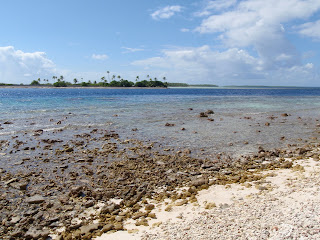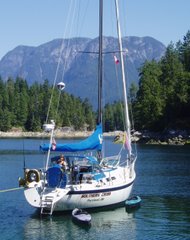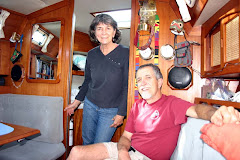NOTE: I have no idea why the photos are so large. Apparently someone at Blogger has changed the way the program operates, and I have no time to learn how to modify my photos to fit the new system. Hopefully my readers can find a way to view them properly!
After over 2 weeks of exploring Nuku Hiva, we made the easy 25nm crossing to Ua Pou, our last stop in the Marquesas. We had a very fast beam reach, passing a 45' Maracujo on the way. As we approached the main harbor, Hakahau, another boat appeared from around the NE corner. We could see at least 5 boats already at anchor, hobby-horsing in the NE swell and wind waves. We decided to change course for the W coast. Estrellita had given us a waypoint for a cove they stayed in, called Hikeu. We rounded Cape Punahu and came into the small, deep cove called Vauehi, but it was ringed by fearsome-looking rocky reefs, which were all awash in the 1.5m swell. As we left the bay, a large manta surfaced nearby. We continued S along the W coast, passing the village of Hakamaii.

In another 2 miles we came upon Hikeu, and it looked nice, so we approached and dropped the anchor in 5 fathoms. The water was milky in the cove from waves breaking along the shore, so I couldn't dive the anchor, but it seemed to be holding fine, so we relaxed and enjoyed the afternoon. Just before sunset we jumped in for a swim, then came back aboard to watch for the "Green Flash." It was a small one, but there nonetheless.
The next morning we kayaked ashore to look for fruit and to stretch our legs on the dirt road, which led steeply up into the mountains. After a couple of kilometers, we came to a viewpoint which looked S over Ua Po cove and the village of Hakatao. We met a schoolteacher and his family, doing a day hike to Hakamaii for the May Day holiday.
In the afternoon, we snorkeled in the outer cove, where the underwater visibility was much better - about 50 feet. A couple of local boys were spearfishing from their pirogue in the same area. They were spearing pitifully small fish, like Achilles tangs. Sad to say, but the near-shore waters have been mostly fished out here in the Marquesas, as in most other parts of the Pacific that we have seen.
On Wednesday morning, the S swell had increased to 2m, and it was getting more and more rough at anchor, so we decided to head back over to the N side of the island. As we rounded Cape Punahu, we could tell the NE wind had either died or veered to the normal ESE direction. A huge manta ray dove under our keel, its white belly looking larger than a king-size bedsheet.
We decided to try anchoring in Hakahetau. It is not the calmest anchorage, but with a stern anchor and our flopper stopper, it was just fine. This is one of the most scenic bays in which we have ever anchored.
Landing our kayaks at the concrete wharf was interesting, to say the least. As the surge came in and out, nearly 2m of rise and fall, we had to time our exit from the kayaks and grab onto either a concrete ledge or some steel steps. We made it just fine, and hauled our boats up onto the wharf.
Hakahetau is a lovely town. All the houses are surrounded by very mature and beautiful trees - breadfruit, mango, banyan, coconut palm, pamplemousse, citron, and others that we don't yet recognize. We had hoped to meet some of the locals so that we could buy some fruit and vegetables, but the place seemed deserted. We stopped at the small museum, and then hiked a couple of km up a dirt road to a lovely waterfall.
As at Hakatea, the river water seems much cooler than the sea or the air, and is very refreshing.
After a rather rocky and rolly night, thanks to the failure of two metal pins on our Magma flopper stopper (which is only 2 years old and was quite expensive), we decided to move back to Hakahau.
When we got there, there were only 3 other boats - Wondertime, Leysin, and a huge blue Garcia that was in the process of pulling its anchor.
However, the sailboats were dwarfed by the cargo/cruise ship Aranui 3, on which we had ridden for a week last year. The arrival of the Aranui is a big deal in any Marquesan port. Everyone finds something to celebrate about its arrival!
We set out anchors fore and aft, and paddled ashore to see if we could find any of the crew that might remember us from last year.
And there was Manarii, our favorite crew of all. We weren't sure if he really remembered us, or was just returning our greetings out of politeness. Whatever, it was wonderful to see him again, and we got a local woman to snap our picture with him.
After checking in at the gendarmerie, we learned that the Aranui passengers were having lunch up the road, preceded by traditional singing and dancing. We headed up the road, and immediately ran into another crew woman we remembered from last year, Vaihere, as well as one of the shipboard naturalists, Didier. Vai kindly invited us to join them for lunch, and it was a magnificent feast - poisson cru, goat, pork, crevette, octopus, and samples of the native staples such as breadfruit, taro, and candied bananas.
And the singing and dancing was wonderful. What a treat to run into the Aranui!
The next day we were taken on a drive by a local Frenchman who retired here 7 years ago. Xavier was an English teacher, so for once conversation was not difficult. He took us on the mountainous road to the SE corner of the island, Hohoi. There was fantastic jungle along the way, and breathtaking views of the coastline.
This is not a coast that would normally be approached by boat, as it is on the windward side of the island.
Our mission for the drive was to load up on as much fresh fruit and vegetables as we could find. We bought 2 dozen pamplemousse and a couple of green cocos. We were unable to score any mangos or bananas, but a farmer in Hohoi said he would bring us some on Saturday. Once he arrives, we will be ready for our 400nm passage to the Tuamotus. Our intended landfall is Raroia, where Thor Heyerdahl landed in the Kon-Tiki raft over 50 years ago. But it all depends on wind direction and sea state. If we have to, we will crack off farther west for Makemo or Kauehi.
In any case, we probably won't have email for at least the next week or two. There is supposed to be Internet at Makemo and Fakarava, so we shall see.
 Our principal mission here was collecting 40 liters of water to top off our tanks. By the time we had done this, the current had gone slack and we went out to snorkel the relatively small east pass. This was the 3rd pass we had snorkeled, and was my favorite so far - good coral, plenty of fish, and great viz with the fresh water streaming in from the open sea.
Our principal mission here was collecting 40 liters of water to top off our tanks. By the time we had done this, the current had gone slack and we went out to snorkel the relatively small east pass. This was the 3rd pass we had snorkeled, and was my favorite so far - good coral, plenty of fish, and great viz with the fresh water streaming in from the open sea.

 When we got back to the boat, it was bouncing in a lively manner from the freshening easterly wind, so we decided to up anchor and motor 6 miles to the eastern fringe of the atoll, where there were about a dozen yachts already anchored. We found shelter next to a small motu, and dropped the hook into 15' of sand. Again we were lucky that the bommies were widely spaced, so we didn't need to buoy the chain to keep it out of coral.
We spent 2 days here, beachwalking and exploring the foreshore of the outer reef.
When we got back to the boat, it was bouncing in a lively manner from the freshening easterly wind, so we decided to up anchor and motor 6 miles to the eastern fringe of the atoll, where there were about a dozen yachts already anchored. We found shelter next to a small motu, and dropped the hook into 15' of sand. Again we were lucky that the bommies were widely spaced, so we didn't need to buoy the chain to keep it out of coral.
We spent 2 days here, beachwalking and exploring the foreshore of the outer reef.

 Gardenias and other flowering shrubs and trees wafted their pleasant scent over the boat. We collected enough blossoms to contruct a few leis, for even more perfume onboard.
Gardenias and other flowering shrubs and trees wafted their pleasant scent over the boat. We collected enough blossoms to contruct a few leis, for even more perfume onboard.
 The snorkeling was not great here, so after 2 days we were ready to head back to the pass. This time we anchored west of the main pass, joining Skimmer (whom we had met in Raroia), Knotty Lady, Super Ted, and Victory. Here there was enough coral on the bottom to require us to buoy our chain. But the holding and shelter were excellent here, and combined with the nearby passes and a great atoll to explore on foot and by kayak, this quickly became our new "favorite anchorage" in the Tuamotus.
The snorkeling was not great here, so after 2 days we were ready to head back to the pass. This time we anchored west of the main pass, joining Skimmer (whom we had met in Raroia), Knotty Lady, Super Ted, and Victory. Here there was enough coral on the bottom to require us to buoy our chain. But the holding and shelter were excellent here, and combined with the nearby passes and a great atoll to explore on foot and by kayak, this quickly became our new "favorite anchorage" in the Tuamotus.

 Shortly after we arrived, the Swiss yacht Leysin showed up. We had first met Jacky and Catherine on Nuku Hiva, and had crossed paths twice since then. Despite the language barrier, we enjoyed hanging out with them. Over the next few days we snorkeled all 3 of the passes together.
Shortly after we arrived, the Swiss yacht Leysin showed up. We had first met Jacky and Catherine on Nuku Hiva, and had crossed paths twice since then. Despite the language barrier, we enjoyed hanging out with them. Over the next few days we snorkeled all 3 of the passes together.

 Eventually, two other Mexico boats arrived - Buena Vista, whom we knew fairly well, and Blue Rodeo, whom we had only met once before. Thanks to Mark and Anne for generously sharing their dinghy and compressor. Diving the passes instead of snorkeling them was a real highlight for us!
After 6 days of great fun here, we decided we had to move along if we wanted to see any of the other atolls. It was time for another short overnight passage.
Eventually, two other Mexico boats arrived - Buena Vista, whom we knew fairly well, and Blue Rodeo, whom we had only met once before. Thanks to Mark and Anne for generously sharing their dinghy and compressor. Diving the passes instead of snorkeling them was a real highlight for us!
After 6 days of great fun here, we decided we had to move along if we wanted to see any of the other atolls. It was time for another short overnight passage.














































